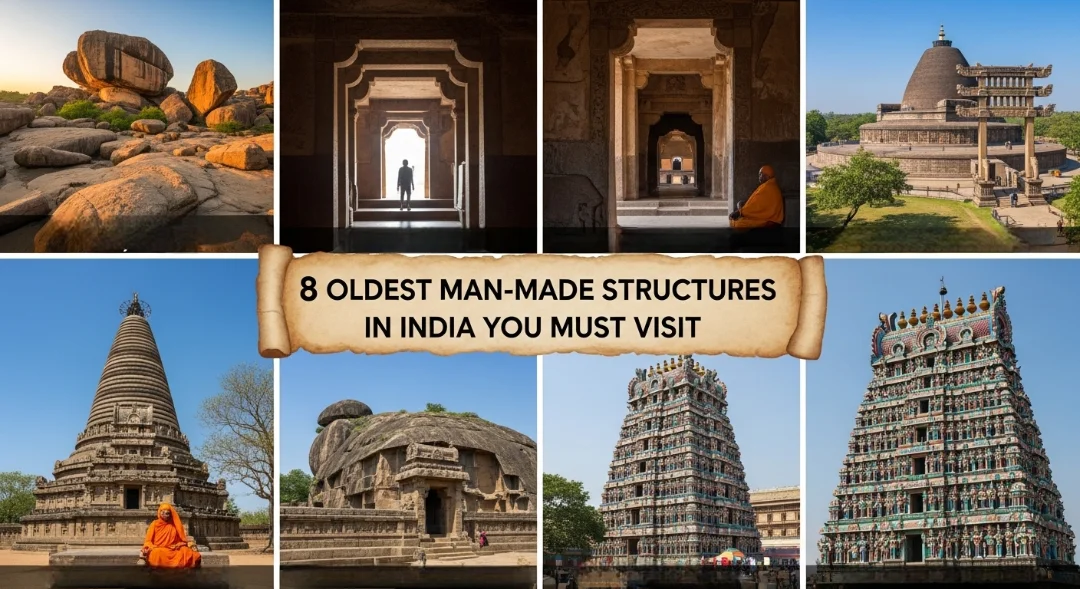India is a land where history isn’t just in books; it’s etched in stone, carved into caves, and built into monuments that have stood for millennia. As a civilization that has witnessed countless eras, cultures, and religions, it’s a living museum of human ingenuity. If you’ve ever wondered what it feels like to touch the roots of a culture, visiting some of the oldest man-made structures in India is a must. These aren’t just ruins; they are living stories that connect us to the past.
If you’re a history buff, a curious traveler, or someone looking for a journey that goes beyond the ordinary, here are eight of the most magnificent and oldest structures in India that will leave you in awe.
1. Bhimbetka Rock Shelters, Madhya Pradesh (30,000+ Years Old)
When you visit the Bhimbetka Rock Shelters, you are literally stepping back in time. Tucked away in the Vindhya mountain ranges, these prehistoric caves are home to some of the earliest art ever found on the subcontinent. The paintings, some over 30,000 years old, vividly depict scenes of hunting, dancing, and the daily life of early humans. It’s a humbling experience to stand where our ancestors once lived and to witness their creativity. These incredible ancient structures are a UNESCO World Heritage Site and offer a unique window into humanity’s beginnings.
- Highlight: The oldest known art in the Indian subcontinent.
- Best Time to Visit: October to March.
2. Barabar Caves, Bihar (3rd Century BCE)
Carved out of a single granite rock during Emperor Ashoka’s reign, the Barabar Caves are the oldest surviving rock-cut caves in India. They were originally used as retreats for the Ajivika sect. What makes these ancient structures so remarkable is their highly polished interiors, a signature of Mauryan architecture. The Lomas Rishi Cave, with its stunning arched facade, is a prime example of the kind of ancient Indian architecture that would later inspire many Buddhist caves.
- Highlight: Early rock-cut architecture and the famous Mauryan polish.
- Best Time to Visit: November to February.
3. Sanchi Stupa, Madhya Pradesh (3rd Century BCE)
Commissioned by Ashoka the Great, the Great Stupa at Sanchi is one of the most famous and oldest man-made structures in India. It is a major Buddhist pilgrimage site, housing relics of the Buddha himself. The stupa is adorned with incredibly detailed gateways known as toranas, which tell stories of Buddha’s life through intricate carvings. Visiting Sanchi is a deep dive into Buddhist art and symbolism, making it an essential part of any heritage tour.
- Highlight: A UNESCO World Heritage Site and a center of Buddhist pilgrimage.
- Best Time to Visit: October to March.
4. Mahabodhi Temple, Bihar (2nd–3rd Century BCE)
The Mahabodhi Temple stands on the very spot where Siddhartha Gautama attained enlightenment under the Bodhi Tree in Bodh Gaya. While the current temple has been restored over centuries, its core structure dates back to ancient times. This temple is a spiritual powerhouse, and for millions of Buddhists worldwide, it is the most sacred of all ancient structures. It is a place for quiet reflection and spiritual awakening.
- Highlight: The enlightenment site of Gautama Buddha.
- Best Time to Visit: October to February.
5. Udayagiri and Khandagiri Caves, Odisha (2nd Century BCE)
These twin hills near Bhubaneswar are home to a fascinating collection of rock-cut caves. These ancient structures were carved for Jain monks during the reign of King Kharavela. The caves are filled with inscriptions and sculptures that offer a glimpse into the lives and beliefs of ancient Jain monks. The Rani Gumpha cave is a particularly beautiful example, showcasing exquisite carvings and historical significance.
- Highlight: An important and historic Jain site.
- Best Time to Visit: November to February.
6. Meenakshi Temple, Tamil Nadu (Early 6th Century CE)
The Meenakshi Temple is not just one of the oldest structures in India but also one of the most breathtaking examples of Dravidian architecture. While the current structure was primarily built by the Nayak dynasty, its origins trace back to the early centuries CE. This vibrant temple is dedicated to Goddess Meenakshi (a form of Parvati) and Lord Sundareswarar (Shiva). Its towering gopurams and countless colorful sculptures make it an immersive cultural and spiritual experience.
- Highlight: One of the oldest and most vibrant Hindu temples in the world.
- Best Time to Visit: October to March.
7. Kailasa Temple, Ellora, Maharashtra (8th Century CE)
The Kailasa Temple is an absolute engineering marvel. Carved entirely from a single rock, this monolithic temple perfectly mimics Mount Kailash, the mythical home of Lord Shiva. The scale, symmetry, and intricate details of this ancient structure are simply mind-blowing. It stands as a testament to the immense skill and vision of the artisans of the Rashtrakuta dynasty, making it one of the most remarkable oldest man-made structures in India.
- Highlight: The largest monolithic structure in the world.
- Best Time to Visit: November to March.
8. Konark Sun Temple, Odisha (13th Century CE)
Though a bit younger than the others on this list, the Konark Sun Temple is still a crowning jewel of Indian heritage. Designed as a massive chariot for the Sun God, with intricately carved wheels and horses, this temple represents the pinnacle of Odishan temple architecture. Despite its partial ruin, its grandeur is undeniable. It’s an unforgettable example of ancient Indian architecture and one of the most famous ancient structures you can visit.
- Highlight: A UNESCO World Heritage Site and an architectural masterpiece.
- Best Time to Visit: October to February.
Must Read: Top 9 UNESCO World Heritage Sites in the US You Can’t Miss
Why You Should Visit These Ancient Structures
These ancient structures are not mere remnants of the past—they are cultural touchstones that continue to shape India’s spiritual and architectural landscape. Each site offers:
- A deep connection to ancient Indian civilization
- Insight into regional architectural styles
- Spiritual and historical richness
- Unforgettable travel experiences for curious minds
Final Thoughts
Visiting these oldest man-made structures in India is more than just a sightseeing trip. It’s an opportunity to connect with the past, to see how civilizations thrived and how art and spirituality shaped a nation. These sites should be on every traveler’s bucket list, offering living proof of India’s enduring heritage and the incredible skill of its ancestors.







